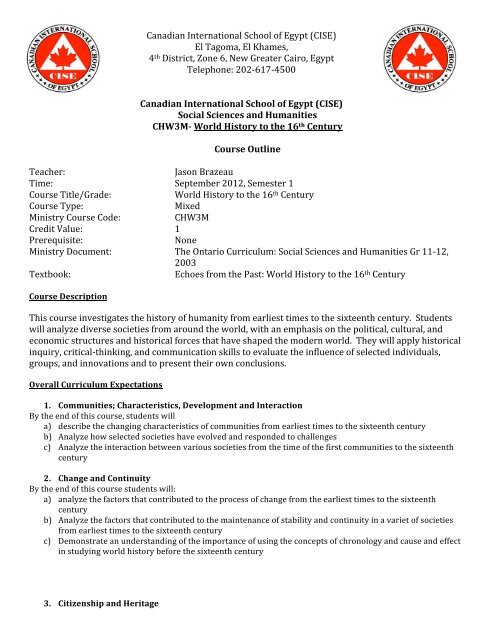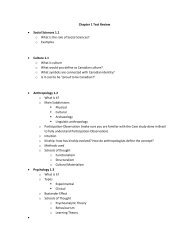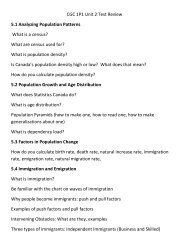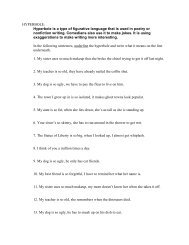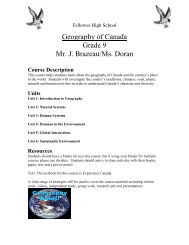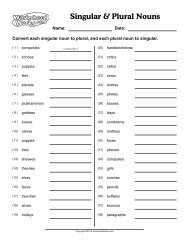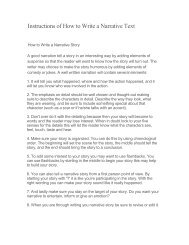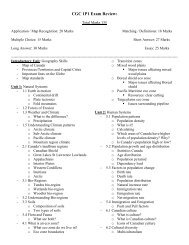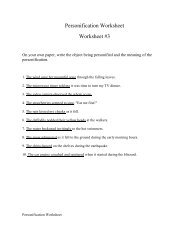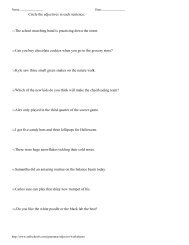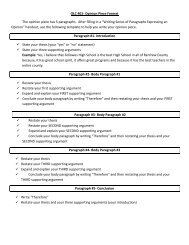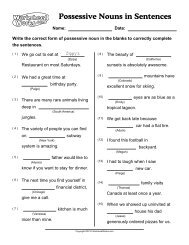CHW3M- Course Outline.pdf - Wikispaces
CHW3M- Course Outline.pdf - Wikispaces
CHW3M- Course Outline.pdf - Wikispaces
- No tags were found...
You also want an ePaper? Increase the reach of your titles
YUMPU automatically turns print PDFs into web optimized ePapers that Google loves.
Canadian International School of Egypt (CISE) El Tagoma, El Khames, 4 th District, Zone 6, New Greater Cairo, Egypt Telephone: 202-‐617-‐4500 Canadian International School of Egypt (CISE) Social Sciences and Humanities <strong>CHW3M</strong>-‐ World History to the 16 th Century <strong>Course</strong> <strong>Outline</strong> Teacher: Time: <strong>Course</strong> Title/Grade: <strong>Course</strong> Type: Ministry <strong>Course</strong> Code: Credit Value: Prerequisite: Ministry Document: Textbook: Jason Brazeau September 2012, Semester 1 World History to the 16 th Century Mixed <strong>CHW3M</strong> 1 None The Ontario Curriculum: Social Sciences and Humanities Gr 11-‐12, 2003 Echoes from the Past: World History to the 16 th Century <strong>Course</strong> Description This course investigates the history of humanity from earliest times to the sixteenth century. Students will analyze diverse societies from around the world, with an emphasis on the political, cultural, and economic structures and historical forces that have shaped the modern world. They will apply historical inquiry, critical-‐thinking, and communication skills to evaluate the influence of selected individuals, groups, and innovations and to present their own conclusions. Overall Curriculum Expectations 1. Communities; Characteristics, Development and Interaction By the end of this course, students will a) describe the changing characteristics of communities from earliest times to the sixteenth century b) Analyze how selected societies have evolved and responded to challenges c) Analyze the interaction between various societies from the time of the first communities to the sixteenth century 2. Change and Continuity By the end of this course students will: a) analyze the factors that contributed to the process of change from the earliest times to the sixteenth century b) Analyze the factors that contributed to the maintenance of stability and continuity in a variet of societies from earliest times to the sixteenth century c) Demonstrate an understanding of the importance of using the concepts of chronology and cause and effect in studying world history before the sixteenth century 3. Citizenship and Heritage
Essential Evidence A. COURSE WORK 70% -‐Quizzes, Tests, Assignments, Projects B. CULMINATING ACTIVITIES 1: Culminating Activity 10% 2: Examination 20% NOTE: SOME ASSESSMENT/ EVALUATION COMPONENTS MAY BE ALTERED DEPENDING ON TOPIC INTEREST, CLASS DEMAND OR TIME CONSTRAINTS. STUDENTS WILL BE MADE AWARE OF ANY CHANGES WITH AN UNDERSTANDING THAT MODIFICATIONS ARE IN THEIR BEST INTEREST. Achievement Chart Percent Grade Achievement Summary Description Range Level 80-‐100% 4 A very high to outstanding level of achievement. Achievement is above the provincial standard 70-‐79% 3 A high level of achievement. Achievement is at the provincial standard 60-‐69% 2 A moderate level of achievement. Achievement is below but approaching the provincial standard 50-‐59% 1 A passable level of achievement. Achievement is below the provincial standard Below 50% Insufficient achievement of curriculum expectations. A credit will not be granted Late Assignment Policy Students are expected to complete all assignments on time. Teachers and the principals will assist students in developing good work habits, including time management, and in developing the attitudes that lead to success in life, including pride in work done. The cooperation of parents is invited and is essential. Assignments that are late or incomplete: a) Student will not be allowed to enter the class and will be sent down to RM 24 (Mr. Frank) to complete the assignment. The student will not be allowed to enter the class until the assignment is done. The student will then be responsible for any work that is missed in class. b) Parents will be contacted immediately c) The student will receive a 5% penalty each day the assignment is late d) Once the assignment has been marked and distributed back to the other students, you will receive a mark of 0. Academic Honesty
It is expected that all essays, assignments, projects and the like, presented by students for assessment, will be their own work. The advent of the Internet, which is a superb source of information for students, has led to a large increase in plagiarism the presentation of another person’s work as your own. Plagiarism includes students copying into their work, sentences, paragraphs, graphics and so on from another author, without providing an acknowledgment of the source. Plagiarism becomes an increasingly frequent problem as students get older. It is also a problem in post-secondary institutions, which regard it so seriously that they will often require a student who has been academically dishonest to withdraw from their program. The school wishes to cooperate with parents in developing students’ commitment to academically honest practices. If a student presents work for assessment that contains another person’s work, without adequate acknowledgement, the work will be returned un-‐assessed and parents will be contacted to set additional consequences, including suspension, depending on the grade and the extent of the plagiarism. Plagiarized work will be assigned a zero grade. Students are to be treated with respect and dignity. In return, they must demonstrate respect for themselves and for others through acceptable behavior. Respect and responsibility are demonstrated when a student: • Comes to school regularly, on time and ready to learn; • Is prepared for all classes by bringing required material and completing homework assignments on time; • Is responsible for any work missed in classes due to absence; • Shows respect for themselves, for others and for those in authority; • Develops self-‐discipline and shows courtesy through language and actions toward all members of the school community; • Shows respect for school property and the personal belongings of others; • Cooperates with other members of the school community; • Resolves interpersonal conflicts and difficulties through discussions with the other person or through seeking assistance from school personnel; • Refrains from bringing anything to school that may compromise the safety of others (e.g. alcohol, illegal drugs, weapons, objects which may be used as weapons); • Follows the established rules and takes responsibility for his/her actions. If you have any problems or issues throughout the year, I have an open door policy so please come and talk to me. If there is anything that I can do to help I would love to do so. You can also contact me through e-‐mail at jbrazeau@cise-‐eg.com. You can also follow a day to day schedule of the class at www.brazeau.wikispaces.com Thanks Student Signature: _________________________________________________________ Teacher Signature: ________________________________________________________


